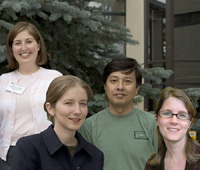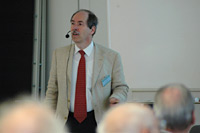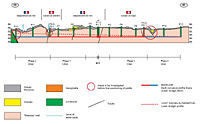 |
|
|
 |
Brian Greene Gives Congress a Tour of the Quantum Universe

Quantum Universe Meets Hollywood: Actor Alan Alda (left), a science supporter and host of the PBS series "Scientific American Frontiers," chats with Brian Greene (center) and Representative Judy Biggert (right) at the R&D Caucus on 9 May in Washington D.C. |
Have you ever tossed a ball at a wall, playing a game of one-man catch? As you tossed that ball again and again and again, have you ever thought about the chance that it could go right through the wall? According to quantum mechanics, this is a real possibility. "It's a small probability, but it is there," said renowned physicist and author Brian Greene, who addressed the Congressional Research and Development Caucus Advisory Committee in Washington, D.C. last week.
"The ideas of modern physics are so strange that they sometimes seem to not have any relevance to real science," he said. "What's stunning is that that there is a chance that we might be able to test these ideas within the next five to six years."
Beginning with Sir Isaac Newton's laws of gravity to lead up to the modern-day string theory, Greene told the story of Einstein's quest to find a "unified theory" of the universe: a single, all-encompassing framework for explaining the cosmos. "How did the universe begin?" Greene asked. "We can make use of the laws that we know to determine what happened to a fraction of a second after it started. A main goal of the unified theory is to discover what happened in the beginning of the universe."
Read more...
-- Elizabeth Clements
|
 |
|
|
 |
ILC NewsLine Survey
If you subscribe to ILC NewsLine, you received a brief survey in your email a few weeks ago. We have already received a number of responses and encourage you to fill out the survey if you have not done so already. Survey responses will continue to be collected through 22 May. The ILC Communicators will meet at KEK on 29-31 May, where the responses will be analysed and discussed. The results will be presented at the GDE meeting in Vancouver this July.
We really appreciate your feedback and your time in filling out the survey. If you did not receive a survey or cannot find the original email, please contact newsline@ilcgde.org.
-- ILC Communicators

Your GDE Communicators: (L-R) Elizabeth Clements, Perrine Royole-Degieux, Youhei Morita and Barbara Warmbein. |
|
|
 |
 |
|
|
 |
EPP2010 – the European version

Nobel laureate Gerard't Hooft giving a speech on the future of physics |
Less than a week after the good news of the EPP2010 report, recommending full American support for LHC experiments and the ILC, the Europeans sat down together to discuss their view of the future of particle physics. The almost 40 members of the CERN Council Strategy Group, the equivalent to the EPP2010 Committee, will write a draft strategy document for discussion and unanimous approval at a special meeting of the CERN Council in Lisbon in July. The outcome of the meeting in Zeuthen will not be made public until the CERN Council has convened in July.
In contrast to the US, there is no central body for funding or policy in Europe – there are universities, national labs, governments of the different countries, the European Commission and CERN. Therefore the only more or less central forum for discussions on particle physics is the CERN Council – any recommendation the Council makes can have a major impact on the national science programmes throughout Europe.
Read more...
CERN Council Strategy Group
-- Barbara Warmbein |
 |
|
|
 |
Civil Engineering studies of the European ILC sites

Longitudinal solution of the CERN sample site project, given as an example. |
The conventional facilities and siting studies are currently organised in a global group within the GDE. Some specific studies, like civil engineering, are totally site-dependent and studied separately in each region.
In Europe, two sample sites have been proposed for the Baseline Configuration Document for the ILC, one at DESY (Germany) and one at CERN (Switzerland and France). These proposed sites benefit from past studies for LEP, LHC, HERA and from the TESLA Technical Design Report. (The ILC layout would follow closely the TESLA layout for the first 32.8 km.) The two sites particularly differ by the composition of the rock and soil underground. At CERN, the bedrock called "molasse" is rather stable and watertight, and dictates a deep tunnel configuration (around 120 metres). The Tesla underground, however, is made of damp sand for the majority, which is in favour of a shallow tunnel (around 20 metres). Because of environmental and technical constraints, the suggested layouts of the sites would be fixed at one end. Actual positioning of the interactions points would thus take into account the final length of the project (after a potential upgrade of the energy).
Read more...
Last Version of the BCD for Conventional Facilities and Siting (.doc)
-- Perrine Royole-Degieux |
 |
|
|
 |
From Interactions.org
15 May 2006
A Ruler to Measure the Universe
A team of astronomers led by Nikhil Padmanabhan and David Schlegel has published the largest three-dimensional map of the universe ever constructed, a wedge-shaped slice of the cosmos that spans a tenth of the northern sky, encompasses 600,000 uniquely luminous red galaxies, and extends 5.6 billion light-years deep into space...
Read more...
From dailypress.com
13 May 2006
Particles not particularly useful
Nuclear physicists learned during recent testing at Jefferson Lab in Newport News that a puzzling subatomic particle contributes little to the electric and magnetic fields that hold atoms together...
Read more...
|
|
 |
New Look and New Logo
Today we inaugurate a new look for the ILC website, as well as a new logo. We have strived to make our website as functional as possible, while also making it attractive. The site is still a work in progress, and we are yet to institute some of the most important features that will be incorporated soon, such as a complete Electronic Data Management System (EDMS). Xeno Media, our web designer from the very beginning, developed our new look, and we thank them for their continued efforts to make our website attractive and functional.
In addition, today we introduce our new logo. Sandbox Studio created the logo, which will now appear on our slides, stationary, business cards and other documents representing the ILC. Again, our thanks to Sandbox, and also to our GDE communications team for converging on this new look and logo design.
Read more...
-- Barry Barish
Director's Corner Archive |
 |
|
|
 |
Register for the Vancouver Linear Collider Workshop
On behalf of the ALCPG and GDE, the Local Organising Committee of the Vancouver Linear Collider Workshop, invites you to the July 2006 joint meeting of the American Linear Collider Physics Group and the International Linear Collider Global Design Effort - organised by TRIUMF. The workshop will be held on the Campus of the University of British Columbia in Vancouver, Canada, from Wednesday July 19 to Saturday July 22, with satellite meetings on July 18th and July 23.
More information...
ILC Related Preprints
hep-ph/0605168
15 May 2006
The Challenge of Determining SUSY Parameters in Focus-Point-Inspired Cases
hep-ph/0605164
14 May 2006
Eluding the BBN constraints on the stable gravitino
physics/0605121
15 May 2006
Simulating the Charge Dispersion Phenomena in Micro Pattern Gas Detectors with a Resistive Anode
hep-ex/0605040
13 May 2006
On the Case for a Super Tau-Charm Factory
hep-ph/0605140
11 May 2006 2
Production of doubly charged vector dilepton pairs at gamma gamma colliders
hep-ph/0605123
11 May 2006
CP Violation in Supersymmetric Theories: stop2 -> stop1 tau- tau+
hep-ph/0605118
Date: Wed, 10 May 2006
The Excited Scalars of the Universal Extra Dimension Model
hep-ph/0605098
9 May 2006
Bounds for Z' Mass in 3-3-1 Models from e+ e- Collisions at ILC and CLIC Energies
EUROTeV Reports:
EUROTeV-Report-2006-004
15 May 2006
Ion Effects in the Damping Rings for ILC --- An Introduction
EUROTeV-Report-2006-006-1
20 February 2006
Status of the ATF extraction line laser-wire.
EUROTeV-Report-2006-007-1
15 February 2006
Test Beams for ILC Final Focus
EUROTeV-Report-2006-008-1
15 February 2006
Summary of Laser-wire Mini Workshop
EUROTeV-Report-2006-009-1
15 February 2006
ILC Laser-wires
EUROTeV-Report 2006 002-1 (CLIC Note 650)
22 January 2006
Electron Cloud in Wigglers |
|

